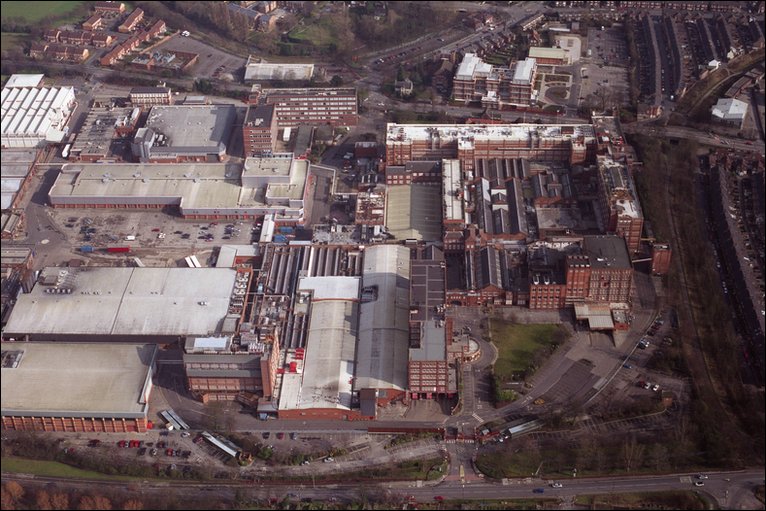The History of Rowntree Mackintosh & Where it is Now
What is Rowntree Mackintosh?
Rowntree Mackintosh is a British confectionery company in York. Find out how a grocer from York gave us some of our favourite confectionery.
Page Contents:
- The Beginning of Rowntree Mackintosh
- How Rowntree Mackintosh became what it is today
- Where is Rowntree Mackintosh now?

The Beginning of Rowntree Mackintosh
Rowntree has a very similar beginning to other successful confectionery companies. It has roots in the Quaker movement.
In 1725, Mary Tuke started a grocer’s shop in York. Her grandfather was among the 4,000 imprisoned for their beliefs in 1660. 11 years later in 1746, Mary decided to take on her nephew William as an apprentice. When she died in 1750 (some sources say 1755), William took over the business. After taking it over, William decided to make some changes and by 1785, the shop was trading under a new name, William Tuke & Sons.
The business ran as two sectors. The first traded in tea and coffee, which was later gained by Twinings after World War 2, and the second manufacturing in chocolate.
In 1862, Henry Isaac Rowntree, who was also a Quaker, bought the chocolate business and decided to set up the shop in Coppergate, York. Two years later, Henry extended his business and built a new factory at Tanner’s Moat. During this time, he was involved with editing and printing the Yorkshire Weekly Press. Henry decided to take on his brother as a partner in 1869 and the business was then renamed H I Rowntree & Co.
How Rowntree Mackintosh became what it is today
Rowntree
To begin with, the company was restricted to cocoa powder and chocolate drops however, their breakthrough came in 1881 when they began to produce the popular fruit pastilles. Previously, these had only been imported from France.
Thanks to these new sweets their business began to balloon and the following year, the brothers bought an old flour mill and converted it. Then, in 1890, they decided to expand further when the company purchased 140 acres of land where their factory still stands today.
By 1906, they employed over 4,000 workers. Around this time, the business announced schemes to benefit their employees. These included a widow’s fund, worker’s dining room, gym, company optician, and a week’s paid holiday, they also reduced hours to just 44 per week.
Other Yorkshire philanthropists such as Sir Titus Salt began to develop purpose built model villages such as Saltaire and Rowntree soon followed in their footsteps. This village was built to house factory workers. The plan was to keep them away from industrial slums which had evolved in parts of York.
They called this new settlement New Earswick. It was built in a green space at the side of the River Foss between 1902 – 1904. Each house had its own garden that was complete with two fruit trees. At the time, the Rowntree family were one of the largest employees in York and at the forefront of social reform for its workers.
Over the years, Joseph stayed true to his Quaker upbringing and philanthropic ideals. He set up several charitable trusts to aid social reform called The Rowntree Trusts which still exist today. In 1912, Joseph opened a park which was named after him. Then, in 1942, the Joseph Rowntree School was built in the city.
During the early 20th Century, the Rowntree business started to decline. People’s tastes were changing which led to their cocoa products to become less popular. Luckily, the marketing director and future chairman George Harris turned the business around with his knowledge of American promotional methods which was “focus on the brand”.
As a result, in the 1930’s Rowntree introduced their most famous and lasting brands. This included Kit Kat (originally called Chocolate Crisp), Aero, Smarties, Dairy Box, and Black Magic. The business wanted to ensure that they had the perfect chocolate assortment when creating Black Magic. This led to them interviewing over 7,000 typical customers.
In 1948, they introduced the well known ‘Polo’ mints to their roster. This was then followed by the Christmas favourite ‘After Eights’ in 1962.
Creamola Food Products and Sunpat Products Ltd became part of Rowntree’s in the 1960’s. The year 1969 saw the company merge with another company, known as Mackintosh.
Mackintosh
In 1890, John Mackintosh and his bride Violet married and they combined their savings of £100 and bought a pastry shop in Halifax. Previously, Violet had worked as a confectioner’s assistant. As a result, she ran the business while John worked at a local cotton mill.
To attract customers, Violet developed Mackintosh’s Celebrated Toffee which was a blend of brittle British Butterscotch and American caramel. In order to put the word out, they created an advert for the local newspaper which was an invitation to the public to try a free sample of the new toffee.
Many locals had seen the advertisement in the newspaper and decided to try it for themselves. The toffee was so popular that it sold out on the first day. A week later, they decided to create a second advert. This read:
“On Saturday last you were eating Mackintosh’s toffee at our expense; next Saturday pay us another visit and eat it at your own expense”
People came from all over the country to pay a visit to the ‘Toffee Shop’ in Halifax. Due to its popularity, Mackintosh’s Celebrated Toffee changed the definition of toffee forever.
Before this sweet was created, people had a different understanding of what it was. Originally, it was used as a description for any sugar or boiled sweet. This success saw them move from retail to large scale manufacturer and they were able to rent a small warehouse in Bond Street.
By 1895, they realised that they needed to expand again in order to meet demands. The business then moved to a larger premises in Hope Street.
In 1899, they converted the business into a limited company called John Mackintosh Ltd. They raised £11,000, along with a £4,000 bank loan, to build a new factory on Queen’s Road. However, this didn’t last long as the factory burnt down in 1909. Luckily the insurance payout they received was enough for them to rebuild.
The business was also able to buy the vacant Albion Mills which would later become their permanent headquarters. Throughout this time, Mackintosh realised the power of advertising. This led John to declare himself as the ‘Toffee King’ in 1902 which quickly stuck.
In 1920, John Mackintosh died and his son Harold took over the business and commissioned the cartoonist Heath Robinson. Harold wanted to create a full page of cartoon advertisements. Part of this was to depict Halifax as ‘Toffee Town’ which it had become known for.
In 1932, the business expanded and purchased the Caley chocolate company from Unilever. As a result, this gave them access to chocolate production. Soon after, the world’s first twist-wrapping machine was invented which allowed Mackintosh to individually sell wrapped chocolate covered toffees.
In 1936, they introduced their most famous brand, Quality Street. They decided to name it after a play of the same name by Peter Pan creator J. M. Barrie. Other well known names soon followed which included Rolo in 1937, Caramac in 1959, and then Tooty Fruity and Toffee Crisp in 1963.
Rowntree and Mackintosh merged together in 1969 when they struck a deal with companies around the world to produce some of their more famous brands under licence. Within this included American chocolate manufacturers Hershey. As a result, the much loved Kit Kat and Rolo were introduced to the US market.
In 1987, the company decided to go public. The following year, Nestle took over for £2.5 billion.
Where is Rowntree Mackintosh now?
Much of the company’s production still takes place in the York factory. They continue to create new products under the Rowntree name.
One of their newer creations is ‘ Rowntree’s Randoms’ in 2009. Another is ‘Rowntree’s Fruit Bottles’ which they produced three years later. As of November 2023, the much loved ‘Caramac’ was discontinued after 64 years of being on our shelves.
Since purchasing Mackintosh, Nestle has made York the centre of their research and development. Chocolate products in the city are set to continue into the future as it has done for so many years.

